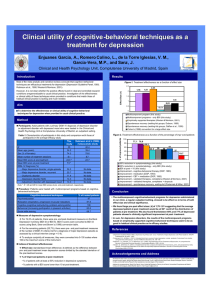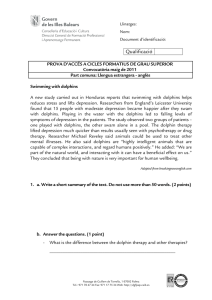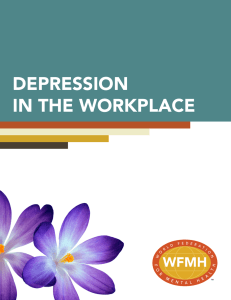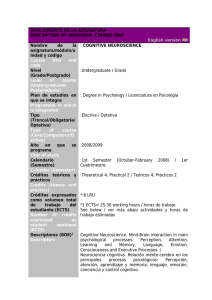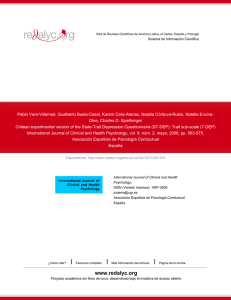Depression: Theory, assessment, and new directions in practice
Anuncio
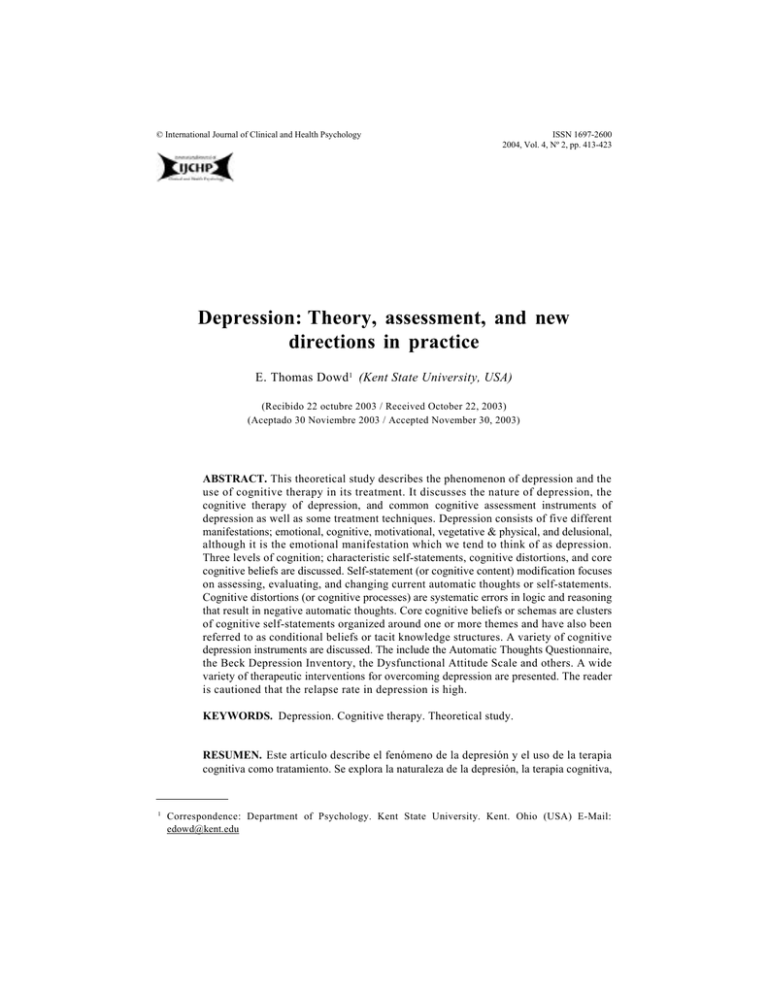
© International Journal of Clinical and Health Psychology ISSN 1697-2600 2004, Vol. 4, Nº 2, pp. 413-423 Depression: Theory, assessment, and new directions in practice E. Thomas Dowd 1 (Kent State University, USA) (Recibido 22 octubre 2003 / Received October 22, 2003) (Aceptado 30 Noviembre 2003 / Accepted November 30, 2003) ABSTRACT. This theoretical study describes the phenomenon of depression and the use of cognitive therapy in its treatment. It discusses the nature of depression, the cognitive therapy of depression, and common cognitive assessment instruments of depression as well as some treatment techniques. Depression consists of five different manifestations; emotional, cognitive, motivational, vegetative & physical, and delusional, although it is the emotional manifestation which we tend to think of as depression. Three levels of cognition; characteristic self-statements, cognitive distortions, and core cognitive beliefs are discussed. Self-statement (or cognitive content) modification focuses on assessing, evaluating, and changing current automatic thoughts or self-statements. Cognitive distortions (or cognitive processes) are systematic errors in logic and reasoning that result in negative automatic thoughts. Core cognitive beliefs or schemas are clusters of cognitive self-statements organized around one or more themes and have also been referred to as conditional beliefs or tacit knowledge structures. A variety of cognitive depression instruments are discussed. The include the Automatic Thoughts Questionnaire, the Beck Depression Inventory, the Dysfunctional Attitude Scale and others. A wide variety of therapeutic interventions for overcoming depression are presented. The reader is cautioned that the relapse rate in depression is high. KEYWORDS. Depression. Cognitive therapy. Theoretical study. RESUMEN. Este artículo describe el fenómeno de la depresión y el uso de la terapia cognitiva como tratamiento. Se explora la naturaleza de la depresión, la terapia cognitiva, 1 Correspondence: Department of Psychology. Kent State University. Kent. Ohio (USA) E-Mail: [email protected] 414 DOWD. Depresión: Theory, assessment and new directions así como instrumentos de evaluación cognitiva. La depresión se muestra en cinco manifestaciones diferentes (emocional, cognitiva, motivacional, vegetativa y física, y delusoria), aunque es la manifestación emocional la que solemos considerar como depresión. Tres niveles de cognición son discutidos: autoverbalizaciones, distorsiones cognitivas y creencias cognitivas. La modificación de autoverbalizaciones (o contenido cognitivo) se enfoca en la evaluación y en el cambio de los actuales pensamientos automáticos. Las distorsiones cognitivas (o procesos cognitivos) son errores sistemáticos de la lógica y el razonamiento que dan resultado a pensamientos negativos automáticos. Las creencias cognitivas o esquemas son grupos de autoverbalizaciones cognitivas basadas en uno o más temas y que también se refieren a creencias condicionales o estructuras de conocimiento táctico. Se describen diversos instrumentos de evaluación cognitiva de la depresión: Automatic Thoughts Questionnaire, Beck Depression Inventory, Dysfunctional Attitude Scale, etc. Se presenta una gran variedad de intervenciones terapéuticas para superar la depresión y se advierte al lector que la pauta de recaída de la depresión es alta. PALABRAS CLAVE. Depresión. Terapia cognitiva. Estudio teórico. RESUMO. Este estudo teórico descreve o fenómeno da depressão e o uso da terapia cognitiva no seu tratamento Discute a natureza da depressão, a terapia cognitiva da depressão, e instrumentos de avaliação cognitiva da depressão assim como algumas técnicas de tratamento. A depressão consiste de cinco manifestações diferentes; emocional, cognitiva, motivacional, vegetativa & física, e alucinatória, apesar de ser a manifestação emocional que tendemos a pensar como depressão. São discutidos três níveis de cognição; auto-afirmações características, distorções cognitivas, e crenças cognitivas nucleares. A modificação de auto-afirmações (ou conteúdo cognitivo) focalizase na avaliação e mudança de pensamentos e auto-afirmações automáticas. Distorções cognitivas (ou processos cognitivos) são erros sistemáticos na lógica e raciocínio que resultam em pensamentos automáticos negativos. Esquemas ou crenças cognitivas nucleares são agrupamentos de auto-afirmações organizadas em volta de um ou mais temas e têm sido referidas como crenças condicionais ou estruturas de conhecimento tácito. São discutidos vários instrumentos de depressão cognitiva, entre eles o Automatic Thoughts Questionnaire, o Beck Depression Inventory, o Dysfunctional Attitude Scale. È apresentada uma larga variedade de intervenções terapêuticas para lidar com a depressão. O leitor é avisado que o grau de recaída na depressão é elevado. PALAVRAS CHAVE. Depressão. Terapia cognitiva. Estudo teórico. Depression is undoubtedly the most common mental health problem, especially when its milder form - dysphoria - is also included. In the United States, it is often called “The common cold of mental health.” Most people occasionally are affected and in most cases it is self-limiting. But sometimes it is not self-limiting and requires psychological or psychiatric treatment and it is certainly more serious than a cold! In this article I shall discuss the nature of depression, the cognitive therapy of depression, and common cognitive assessment instruments of depression as well as some treatment techniques. Int J Clin Health Psychol, Vol. 4, Nº 2 DOWD. Depresión: Theory, assessment and new directions 415 First, let me distinguish among dysthymia, bipolar depression, and unipolar depression. Dysthymia is defined by the DSM IV-TR (American Psychiatric Association, 2000) as “a chronically depressed mood that occurs for most of the day more days than not for at least 2 years.” During periods of depressed mood, at least two of the following additional symptoms are present; poor appetite or overeating, trouble sleeping or too much sleeping, low energy or fatigue, low self-esteem, poor concentration or difficulty making decisions, and feelings of hopelessness. Because of the long-standing and pervasive nature of these symptoms, individuals may not even report them. They might say, “I’ve always been that way.” Others see them as always “down” or sad. Dysthymia is a lowgrade chronic depression very much like a low-grade fever. Bipolar depression was once called manic-depressive disorder and is characterized by mood swings from mania to depression. Sometimes the mania is greater than the depression and sometimes the depression is greater than the mania. Sometimes the cycles are long and sometimes the cycles are short. Bipolar disorder is a true medical condition and medication is the treatment of choice (Basco and Rush, 1996). All that cognitive therapy or indeed any therapy can do is to help the patients manage their medication. Unipolar depression, generally major depressive disorder, is what is commonly meant by the word, “depression.” It is characterized by one or more major depressive episodes (DSM-IV-TR). An episode is a period of at least 2 weeks during which there is either depressed mood or the loss of interest or pleasure in nearly all activities. There are also additional symptoms such as changes in appetite or weight, sleep difficulties, decreased energy, feelings of worthlessness or guilt, difficulty in thinking or concentrating, recurring thoughts of death, or thoughts or plans of suicide. To observers, this appears serious and obvious. While symptoms such as crying or emotional sadness are the most obvious symptoms, other features such as difficulty making decisions, loss of interest in pleasurable activities, and motivational problems can also indicate depression, although perhaps not as obviously. Depression consists of five different manifestations; emotional, cognitive, motivational, vegetative & physical, and delusional (A.T. Beck, 1967). It is the emotional manifestation that we tend to think of as depression. The original model of depression as developed by Aaron T. Beck (A.T. Beck, Rush, Shaw, and Emery, 1979) saw it as characterized by a negative view of the self (e.g. “I am a loser”), the world (e.g. people will hurt me if I give them a chance”), and the future (e.g. things will never get better, only worse”). Beck was careful not to say that these dysfunctional thinking patterns necessarily caused depression (though they might in some circumstances) but that they were associated with depression. A complex mixture of biological variables, social factors, and psychological aspects likely causes depression. But there appears to be a cycle of cognition, affect or emotion, and behavior resulting in what has been called the downward spiral of depression. For example, the thought, “I am a hopeless loser” in response to a bad life event such as the loss of employment can result in feelings of sadness and apathy. Therefore the individual does not even look for other employment that in turn leads to further negative self-talk as well as further depressive feelings. But it is not even certain what causes cognitive change in cognitive behavior therapy (Whisman, 1993). Does the therapy directly change cognitive phenomena such as negative self-talk? Does the therapy provide a set of skills Int J Clin Health Psychol, Vol. 4, Nº 2 416 DOWD. Depresión: Theory, assessment and new directions that helps patients handle these negative self-statements when they do occur? Does the cognitive rationale provide hope and optimism? We don’t yet know. Whether the thoughts or the behavior comes first, it appears that changing these dysfunctional thinking patterns can reduce depression. On the other hand, as I showed in a study years ago (Kelly, Dowd, and Duffey, 1983), depressed patients became less depressed as a result of therapy when behavioral strategies were used first and then followed by cognitive strategies rather than the reverse. When cognitive strategies were followed by behavioral strategies, there was a period of relapse and the patients never did improve as much as those in the first group. Perhaps, as A.T. Beck et al. (1979) pointed out years ago, it is better to begin with behavioral change strategies. Cognitive therapy has been shown to be of great benefit in helping clients to overcome unipolar depression as well as probably dysthymia. A number of outcome studies have consistently shown that cognitive behavior therapy is at least as effective as pharmacotherapy (medication maintenance) for the treatment of acute symptoms. The famous study in the United States sponsored by the National Institute of Mental Health (NIMH) showed that cognitive therapy, interpersonal therapy, and pharmacotherapy (Imipramine) were equally effective with less severe cases of depression but that Imipramine was more effective for people with more severe depression (Elkin et al., 1989). However, some later studies have showed that cognitive behavior therapy is at least as effective as pharmacotherapy even for severely depressed patients (e.g. DeRubeis, Gelfand, Tang, and Simons, 1999; Hollon et al., 1992). Aaron Beck thought that cognitive therapy was not used appropriately in one of the sites in the original NIMH study so perhaps those results should not be seen as the best comparison of cognitive therapy with other treatments for depression. Keith Dobson and his colleagues have performed two meta-analyses (Dobson, 1989; Dobson & Dozois, 1998) that have examined comparisons of cognitive therapy for depression to alternative therapies and control groups. Dobson (1989) found that cognitive therapy was superior in outcome to all comparisons, including wait list and placebo, medications, behavior therapy, and other psychotherapies. He admitted, however, that some of the studies he used were methodologically weak and the number of studies for some comparisons was small. In an attempt to remedy these problems, he conducted a second meta-analysis that investigated follow-up effects and used the Hamilton Rating Scale in addition to the Beck Depression Inventory. The results of the second metaanalysis were considerably less optimistic. Only the comparison of cognitive therapy to wait list and placebo groups was consistently significant. While even the most promising of these studies have not shown that cognitive behavior therapy is consistently and significantly better than alternative forms of treatment, there have been follow-up studies that indicate that cognitive behavior therapy may be associated with lower rates of relapse than other treatments (e.g. Evans et al., 1992; Hollon, 2003; Nezu, Nezu, Trunzo, and McClure, 1998). Thus, cognitive therapy may provide patients with coping skills or revised thinking patterns they can use in handling future problems. In summary, cognitive behavior therapy has been shown to be useful in helping people to overcome or at least reduce their level of depression. While it has not been Int J Clin Health Psychol, Vol. 4, Nº 2 DOWD. Depresión: Theory, assessment and new directions 417 shown to be consistently and significantly better than alternative treatments, it seems to be at least as effective even for cases of serious depression. There is even evidence that it may be especially valuable in preventing relapse. Originally, the cognitive behavior therapy of depression focused on assessing, evaluating, and changing automatic thoughts or self-statements. These are the types of thoughts that people have about many events in their lives, such as, “I’ll never understand this class” or, “I’ll never be able to give a good speech.” These are thoughts or verbal images that are involuntary and are part of the human stream of consciousness. In healthy people, these thoughts consist of a mixture of positive and negative, with more of the former than the latter. In depression they are mostly negative. They are sometimes referred to as surface cognitions or cognitive content. Because they are involuntary and unrecognized they are not evaluated to see if they are true or even plausible. Although they are unrecognized, patients can usually begin to recognize them with help from the therapist. The early cognitive therapy for depression focused on identifying these negative automatic thoughts and evaluating the evidence for and against them. The unspoken assumption was that this evaluation would demonstrate to patients how unrealistic their negative automatic thoughts really were so they could be replaced with presumably more realistic and positive automatic thoughts. However, Alloy and Abramson (1979) found something really quite annoying. They discovered “depressive realism” which means that depressed people often perceive things more realistically and accurately than do nondepressed people! Taylor and Brown (1988) reviewed evidence that demonstrated unrealistically positive self-perceptions are related to better mental health. In partial support, another study (Wright, 2000) found that students who were unrealistically positive about their academic abilities received higher grades the following term than students who were realistic or unrealistically negative about their abilities. In general, it has been found that most people think they are above average, which is a statistical impossibility. Therefore, a certain amount of self-deception may be helpful to people’s mental health and even their behavior and may act as an antidote to depression. Too much honesty about yourself may be bad for your mental health! Unrealistically positive views may not always be best, however. Colvin, Block, and Funder (1995) found that overly positive self-evaluations (compared to trained examiners or friends) resulted in more negative interpersonal ratings of their personality characteristics by these raters. Schwartz and Garamoni (1989) found that an optimal level of mental health was characterized by a ratio of positive to negative selfstatements of .62. A ratio well below 50-50 was associated with depression whereas a ratio well about .62 was associated with an overly “Pollyannaish” attitude. An internal dialogue of 50% - 50% was called the “internal dialogue of conflict.” Perhaps a little self-delusion is helpful but much self-delusion is not. The automatic thoughts are examples of what we think. The next level of cognition is known as cognitive processes. These are the cognitive distortions identified by J.S. Beck and are examples of how we think. They can be thought of as systematic errors in logic and reasoning that result in negative automatic thoughts, such as personalization, dichotomous thinking, magnification/minimization, and discounting the positive. There are other cognitive models that look at cognitive processing errors that may be associated Int J Clin Health Psychol, Vol. 4, Nº 2 418 DOWD. Depresión: Theory, assessment and new directions with depression. The helplessness/hopelessness theory of depression (Abramson, Metalsky, and Alloy, 1989) suggested that depression is caused by internal, stable, and global attributions for bad events and external, unstable, and specific attributions for good events. Miner and Dowd (1996) found that negative life events, current problems, and problem solving ability were each related to depression. Negative social comparisons, in which we compare ourselves negatively to others, is also associated with depression. Self-esteem seems to be a mediating variable because it acts as a buffer to depression in people who otherwise might be expected on the basis of their cognitive content and cognitive processes to become depressed. Pengilly and Dowd (2000) found the level and amount of social support to be important as a buffer to depression. The third level of cognition is that of schemas or enduring structural components of cognition, sometimes known as tacit or implicit knowledge (Dowd and Courchaine, 1996). Self-schemas, or schemas about one’s self, are especially important. Schemas can be seen as clusters of cognitive self-statements organized around one or more themes and have also been referred to as conditional beliefs or core cognitive schemas (J.S. Beck, 1995). An example of a conditional belief might be, “If I never offend anyone, then people will like me.” Examples of core beliefs are, “I’m inadequate, I’m unlovable,” I’m a failure,” or “People can’t be trusted.” These can be seen as tacit rules about oneself, the world, and one’s place in the world. Notice how the first two examples are restatements of Freud’s answer regarding what people ought to be able to do well; “Lieben und Arbeiten.” (To love and to work). These rules are laid down early in life, often before children can use language well, so they are extremely resistant to assessment and change. They are typically experienced by people as, “That’s just the way things are!” Perhaps the most comprehensive organization of core cognitive schemas are the Early Maladaptive Schemas (EMSs) developed by Young (2003). He defined a schema as a broad and pervasive theme or pattern regarding one’s self and relationship to others, that developed during childhood or adolescence, and that is dysfunctional. There are currently 18 EMSs that are organized into five clusters. Young hypothesized that patients generally have two, sometimes three, dysfunctional EMSs that may be responsible for their problems. Several of these EMSs may be associated with depression, such as Emotional Deprivation, Abandonment/Instability, Defectiveness/Shame, and Failure. There are a variety of ways of measuring depression. Perhaps the best known is the Beck Depression Inventory (BDI; Beck, Ward, Mendelson, Mook, and Erbaugh, 1961). The BDI consists of 21 items, which are rated for intensity on a scale of 0 to 3, and reflect attitudes and symptoms frequently shown in depressed patients. It is a self-report measure and is best used as a measure of the severity of depression. It can be especially useful for measuring session-by-session changes in depression. Because the BDI scores can be elevated for reasons other than depression (e.g. low self-esteem), it should not be used to assess the presence of depression. It is commonly used, however, for this purpose. Spielberger, Ritterband, Reheiser, and Brunner (2003) attempted to identify two separate factors of cognitive and affective components of depression, measured collectively by 40 items drawn from the BDI and three other depression measures. Instead of finding cognitive and affective factors, however, they found two factors that identified the presence (Dysthymia) or absence (Euthymia) of state and trait depression. Int J Clin Health Psychol, Vol. 4, Nº 2 DOWD. Depresión: Theory, assessment and new directions 419 Spielberger and his colleagues have also investigated psychometric data for the Spanish experimental version of the State-Trait Depression Questionnaire. Spielberger, Carretero-Dios, de los Santos-Roig, and Buela-Casal (2002a), investigating the Trait sub-scale, found an internal consistency reliability of .95 and a test-retest reliability (3+ months) of .71. The correlation between the State-Trait Anxiety Inventory (Spielberger, Gorsuch, and Lushene, 1970) and all scales in the study was high, indicating a significant correlation between anxiety and depression. Women scored as more depressed than men. Again, two factors of Dysthymia and Euthymia were identified. Spielberger, Carretero-Dios, de los Santos-Roig, and Buela-Casal (2002b), investigating the State sub-scale, found they were able to induce State depression by appropriate experimental manipulations, indicating the scale is a sensitive measure of transitory depression. They also found two factors, Dysthymia and Euthymia. The Hamilton Rating Scale for Depression (HRSD; Hamilton, 1967) is a clinicianscored measure that can be used to assess the presence of depression. Its 17 items are scored by one or two trained observers and can assess affective (emotional), cognitive, behavioral, and vegetative (lack of motivation) components of depression. Because clinicians score it, it is less vulnerable to self-presentational bias. There are several measures of depressive cognitions. The Automatic Thoughts Questionnaire (ATQ; Hollon and Kendall, 1980) assesses the frequency with which 30 depression-related thoughts have spontaneously entered the patient’s head during the last week. The Beck Hopelessness Scale (BHS; Beck, Weissman, Lester, and Trexler, 1974) is a measure of the hopelessness component of depression and is a good measure of suicide potential. The Daily Record of Dysfunctional Thoughts (A. T. Beck et al., 1979) is a less-structured instrument in which patients record their spontaneous automatic thoughts in situations that arouse unpleasant emotions. The Cognitive Bias Questionnaire (CBQ; Hammen and Krantz, 1976) assesses dysfunctional cognitive processes by asking patients to select one of four possible responses to six problematic situations. The Dysfunctional Attitude Scale (DAS; Weissman and Beck, 1978) is used to measure core assumptions, beliefs, and tacit rules about self-evaluation and assesses the extent to which patients agree with certain depressogenic beliefs and attitudes. These are most commonly concerning social approval and perfectionist standards of performance. The Cognitive Response Test (CRT; Watkins and Rush, 1983) provides a more open-ended measure of dysfunctional depressive thinking. Patients are asked to complete sentences such as, “When I consider being married...” with the first thought that comes into their mind. Responses are scored according to criteria for irrational depressive thinking. I now present some therapeutic interventions for overcoming depression. First, let me caution the reader that the relapse rate for depression, regardless of the type of therapy used, is rather high. In general, the more severe the depression and the more frequent the depressive episodes, the more likely the patient is to relapse. But, as I mentioned earlier, cognitive therapy appears to reduce relapse more than some other therapies. A.T. Beck et al. (1979), in their Cognitive Therapy of Depression, included a list of techniques. This list has been expanded over the years and now has become quite comprehensive. For example, Rian Mullin, in his Handbook of Cognitive Therapy Int J Clin Health Psychol, Vol. 4, Nº 2 420 DOWD. Depresión: Theory, assessment and new directions Techniques (1986), lists 75 different techniques and this list is not comprehensive. Some of the more common cognitive therapy techniques that might be useful in reducing depression are shown in Table 1. TABLE 1. Typical Techniques in Cognitive Therapy. Behavioral - Activity scheduling/monitoring - Positive self-statement logs - Behavioral experiments - Exposure hierarchies - Graded task assignments - Distraction techniques - Relaxation exercises - Acting “as if” - Social skills training - Assertiveness training - Time management - Exercise - Reduction of stimulants - Active listening to therapy tape Cognitive - Evaluating automatic thoughts - Identifying underlying beliefs - Restructuring beliefs - Modifying images - Labeling distortions - Cognitive rehearsal - Self-instruction - Thought-stopping - Flash cards/posters - Historical exploration & review of the evidence - Role playing - Imaging feared consequences (“What’s the worst...?”) - Problem-solving - Examining advantages & Disadvantages Recent research in the cognitive therapy of depression has shown the importance of the cognitive diathesis-stress model of depression. This model proposes that negative cognitions are a vulnerability factor that interacts with negative life events (e.g. stress) to contribute to the onset and maintenance of depression. Thus, people who have a negative cognitive style are more likely to become depressed when they experience stressful life events than are people who do not have such a style. Hilsman and Garber (1995) found this was true. Students who reported a negative, depressive, explanatory style for their lack of academic control and competence reported more distress after receiving poor grades than did students without such cognitions. Overholser (1996) found that depressed patients reported experiencing significantly more stressful life events during the last six months than did nondepressed people. There is also a significant correlation between the number of negative life events experienced over time and the level of depression. A depressive episode may be triggered by a stressful life event. Of course, the direction of causality is not always clear. Are people depressed because of stress in their lives or do they report more stress because they are depressed? Does the direction matter? In any event, there are techniques that we can use to reduce stress and therefore depression. These are shown in Table 2. Int J Clin Health Psychol, Vol. 4, Nº 2 421 DOWD. Depresión: Theory, assessment and new directions TABLE 2. Coping with Precipitating Events. 1. Reduce habitual reactions. Disrupt the habit basis of maladaptive coping. Encourage or push a small change to start a “ripple effect.” 2. Reduce coping by avoidance. Includes reducing negative emotions by alcohol or drug use, overeating, avoiding people, or thoughts related to the problem. These avoidance strategies are strongly related to depression. 3. Reduce tendencies for social withdrawal. Depression has been linked with withdrawing from people and events and (e.g.) watching television. 4. Reduce tendencies for rumination and blame. Patients may ruminate, blame themselves for past events, engage in wishful thinking. May ask unproductive questions like, “Why did this happen to me? Self-blame immobilizes and depresses. 5. Reduce perfectionistic tendencies. Depressed people may have unrealistically high standards and use dichotomous thinking. 6. Reduce confrontation with others. People may respond to stress by being hostile or aggressive to others. 7. Confront the problem directly. Depressed patients tend to avoid the problem and engage in “emotion-focused” coping. Encourage “Task focused” Coping, e.g. “What will you do - and when - and how?” 8. Maintain a sense of control. Repeated failure promotes a sense of helplessness, which increases depression, which reduces control, etc... Perceived uncontrollability reduces patients’ motivation. Encourage small actions which can increase feelings of control. 9. Use problem-solving techniques. Lack of effective problem-solving can make people vulnerable to depression. Art Nezu and his colleagues have developed a problem solving therapy for depression Nezu et al., 1998). Therapist can be a “problem-solver” and apply the 5 processes (problem orientation, problem definition and formulation, generation of alternatives, decision making, solution implementation and verification). 10. Focus on solutions instead of problems. This encourages a hopeful, future-orientation instead of a past, hopeless orientation. 11. Focus on positive and happy experiences. Depressed people are likely to attribute negative life experiences to internal, stable, global causes. Help them to reattribute through examination of the evidence. Also, through mood state congruence, depressed people have great difficulty remembering times when they were happy. Use of positive thoughts can help reduce depressive effects of negative life events. 12. Utilize client’s social resources. Availability of family and social resources can help reduce depression. 13. Help clients express negative emotions but do not dwell on them. It will increase depression in the short run. 14. Use Reframing. It is the examination of the positive aspects of a situation commonly interpreted as negative. In summary, the cognitive therapy of depression is considerably more complex than we once thought. A.T. Beck’s et al. (1979) original proposal that it could be cured in 16 session now seems overly optimistic - though that still might be true in cases of first-episode, acute depression. But recurrent, characterological depression may have biological, historical, and social causes - as well as situational causes. Relapse is more of a problem than we once thought and the more depressive episodes people have had, the more likely they are to relapse. It is truly a demanding problem. Int J Clin Health Psychol, Vol. 4, Nº 2 422 DOWD. Depresión: Theory, assessment and new directions References Alloy, L.B. and Abramson, L.Y. (1979). Judgement of contingency in depressed and nondepressed students: Sadder but wiser? Journal of Experimental Psychology: General, 108, 441-485. Abramson, L.Y., Metalsky, G.I., and Alloy, L.B. (1989). Hopelessness depression: A theory-based subtype of depression. Psychological Review, 96, 358-372. American Psychiatric Association (2000). Diagnostic and statistical manual of mental disorders (4th Edition). Washington D.C., American Psychiatric Association. Basco, M..R. and Rush, A.J. (1996). Cognitive-behavioral therapy for bipolar disorder. New York: Guilford. Beck, A.T. (1967). Depression: Causes and treatment. Philadelphia: University of Pennsylvania Press. Beck, A.T., Rush, A.J, Shaw, B., and Emery, G. (1979). Cognitive therapy of depression. New York: Guilford. Beck, A.T. , Ward, D.H., Mendelson, M. Mock, J.E. and Erbaugh, J.K (1961). An inventory for measuring depression. Archives of General Psychiatry, 4, 561-571. Beck, A.T., Weissman, A., Lester, D., and Trexler, L. (1974). The measurement of pessimism: The Hopelessness Scale. Journal of Consulting and Clinical Psychology, 42, 861-865. Beck, J.S. (1995). Cognitive therapy: Basics and beyond. New York: Guilford. Colvin, C.R., Block, J., and Funder, D.C. (1995). Overly positive self-evaluations and personality: Negative implications for mental health. Journal of Personality and Social Psychology, 68, 1152-1162. DeRubeis, R.J., Gelfand, L.A., Tang, T.Z., and Simons, A.D. (1999). Medications versus cognitive behavior therapy for severely depressed outpatients: A meta-analysis of four randomized comparisons. American Journal of Psychiatry, 156, 1007-1013. Dobson, K.S. (1989). A meta-analysis of the efficacy of cognitive therapy for depression. Journal of Consulting and Clinical Psychology, 57, 414-419. Dobson, K.S. and Dozois, D. (1998, July). The effectiveness of cognitive therapy for depression: An updated meta-analysis. Paper presented at the World Congress of Behaviour and Cognitive Therapies, Acapulco. Dowd, E.T. and Courchaine, K.E. (1996). Implicit learning, tacit knowledge, and implications for stasis and change in cognitive psychotherapy. Journal of Cognitive Psychotherapy: An International Quarterly, 10, 163-180. Elkin, I., Shea, M.T., Watkins, J., Imber, S.D., Sotski, S.M., Collins, J.F., Glass, D.R., Pilkonis, P.A., Leber, W.R., Docherty, J.P., Fiester, S.J., and Parloff, M.B. (1989). NIMH treatment of depression collaborative research program: General effectiveness of treatments. Archives of General Psychiatry, 46, 971-983. Evans, M..D., Hollon, S.D., DeRubeis, R.J., Piasecki, J.M., Grove, W.M., Garvey, M.J., and Tuason, V.B. (1992). Differential relapse following cognitive therapy and pharmacotherapy for depression. Archives of General Psychiatry, 49, 802-808. Hamilton, M. (1967). Development of a rating scale for primary depression illness. British Journal of Social and Clinical Psychology, 6, 278-296. Hammen, C.L. and Krantz, S.E. (1976). Effects of success and failure on depressive cognitions. Journal of Abnormal Psychology, 85, 577-586. Hilsman, R. and Garber, J. (1995). A test of the cognitive diathesis-stress model of depression in children: Academic stressors, attributional style, perceived competence, and control. Journal of Personality and Social Psychology, 69, 370-380. Hollon, S.D. (2003). Does cognitive therapy have an enduring effect? Cognitive Therapy and Research, 27, 71-76. Int J Clin Health Psychol, Vol. 4, Nº 2 DOWD. Depresión: Theory, assessment and new directions 423 Hollon, S.D., DeRubeis, R.J., Evans, M.D., Wiemer, M.J., Garvey, M.J., Grove, W.N., and Tuason, V.B. (1992). Cognitive therapy and pharmacotherapy for depression: Singly and in combination. Archives of General Psychiatry, 49, 774-781. Hollon, S.D. and Kendall, P.C. (1980). Cognitive self-statements in depression: Development of an automatic thoughts questionnaire. Cognitive Therapy and Research, 4, 383-396. Kelly, F.D., Dowd, E.T., and Duffey, D.K. (1983). A comparison of cognitive and behavioral intervention strategies in the treatment of depression. British Journal of Cognitive Psychotherapy, 1, 51-58. Miner, R.C. and Dowd, E.T. (1996). An empirical test of the problem solving model of depression and its application to the prediction of anxiety and anger. Counselling Psychology Quarterly, 9, 163-176. Nezu, A.M., Nezu, C.M., Trunzo, J.J., and McClure, K.S. (1998). Treatment maintenance for unipolar depression: Relevant issues, literature review, and recommendations for research and clinical practice. Clinical Psychology: Science and Practice, 5, 496-512. Overholser, J.C. (1996). Cognitive-behavioral treatment of depression, Part VII: Coping with precipitating events. Journal of Contemporary Psychotherapy, 26, 337-360. Pengilly, J.W. and Dowd, E.T. (2000). Hardiness and social support as moderators of stress. Journal of Clinical Psychology, 56, 813-820. Schwartz, R.M. and Garamoni, G.L. (1989). Cognitive balance and psychopathology: Evaluation of an information processing model of positive and negative state of mind. Clinical Psychology Review, 9, 271-294. Spielberger, C.D., Carretero-Dios, H., de los Santos-Roig, M., and Buela-Casal, G. (2002a). Spanish experimental version of the State-Trait Depression Questionnaire (ST-DEP): Trait sub-scale (T-DEP). Revista Internacional de Psicología Clínica y de la Salud/International Journal of Clinical and Health Psychology, 2, 51-69. Spielberger, C.D., Carretero-Dios, H. de los Santo-Riog, M., & Buela-Casal, G. (2002b). Spanish experimental version of the State-Trait depression Questionnaire (ST-DEP): State subscale (S-DEP). Revista Internacional de Psicología Clínica y de la Salud/International Journal of Clinical and Health Psychology, 2, 71-89. Spielberger, C.D., Gorsuch, R.L., and Lushene, R.E. (1970). Manual for the State-Trait Anxiety Inventory (Self-evaluation Questionnaire). Palo Alto, CA: Consulting Psychologists Press. Spielberger, C.D., Ritterband, L.M., Reheiser, E.C., and Brunner, T.M. (2003). The nature and measurement of depression. Revista Internacional de Psicología Clínica y de la Salud/ International Journal of Clinical and Health Psychology, 3, 209-234. Taylor, S.E. and Brown, J.D. (1988). Illusion and well-being: A social psychological perspective on mental illness. Psychological Bulletin, March. Watkins, J.T. and Rush, A.J. (1983). Cognitive response test. Cognitive Therapy and Research, 7, 425-436. Weissman, A.N. and Beck, A.T. (1978). Development and validation of the Dysfunctional Attitude Scale: A preliminary investigation. Paper presented at the annual meeting of the American Educational Research Association, Toronto. Whisman, M.A. (1993). Mediators and moderators of change in cognitive therapy of depression. Psychological Bulletin, 114, 248-265. Wright, S.S. (2000). Looking art the self in a rose-colored mirror: Unrealistically positive selfviews and academic performance. Journal of Social and Clinical Psychology, 19, 451462. Young, J.E. (2003). Schema therapy: A practitioner’s guide. New York: Guilford. Int J Clin Health Psychol, Vol. 4, Nº 2

